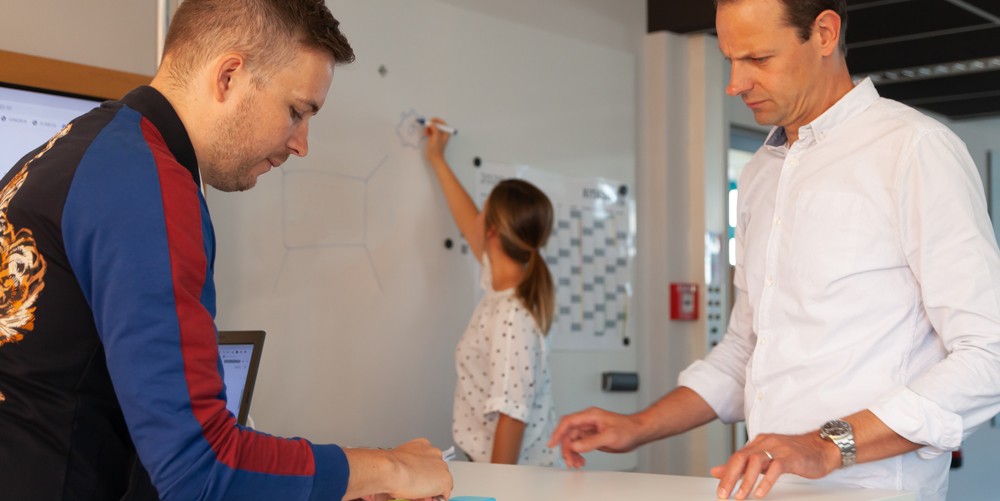
12. Oct 2020
“Waterfall” or “agile”? – how to choose the right approach for your project:
Different projects require different approaches. Two very contrasting approaches are the waterfall model and the agile approach. XITASO Agile Coach Baptiste Grand shows you how to find out which method is right for your project.
The Stacey Complexity Matrix
If you are asking yourself whether you should use the waterfall model or whether you want to proceed agilely, the Stacey matrix can be used.
Two questions then arise in the foreground:
- Do you know what to do?
- Do you know how to do that?

If you can answer “yes” to both questions, you are lucky and there is no need to apply agile methods. Actually, you don’t need any project management methods, because you know exactly what to do and how to do it – so you just have to do it!
If you are more or less sure what to do and how to do it, then you are in the complicated area of the matrix. Here you can manage your project with a waterfall method. But you could also use agile approaches and try Kanban or Scrum, for example.
As the uncertainty on the requirement axis increases, the risks in terms of planning the scope, time and budget of your project become exponentially higher and higher. At this point, it is advisable to remedy one of these three limitations in order to reduce the overall complexity. As a rule of thumb, it is often easiest to reduce time pressure by using time-boxing techniques such as sprints, for example.

When you get into the chaotic area on the Matrix, you’re in trouble! You don’t know what to do or how to do it and should stop your activities as a first step. Because in the realm of chaos, the risk is extremely high that you deliver a dysfunctional product, too late and over budget. So first take a step backwards, take a deep breath and question again what exactly you want to do and why.
If you were able to locate your project on the Stacey matrix, you should be able to decide how to control your project. You are now ready to go one step further.
People as the biggest challenge
Large projects are often very complex and are handled by large teams. And once you’re dealing with people, nothing is black or white anymore. Considering this, it would make more sense to look at the Stacey matrix from a slightly different perspective and reformulate the two questions accordingly:
- How confident are you that you know what to do?
- How confident are you that you know how to do that?
However, people are usually not so good at assessing their own position in terms of risks and certainties. That’s why poker is such a popular game; we have to estimate our chances of winning based on the current situation. And very often we are wrong, which is what makes the game so exciting in the first place.
What can we do about it? And what are the next logical steps?
The checklist illusion
Now the temptation is obvious to simply remove this human-related part from the equation by defining a clear, criteria-based checklist that can be used to decide which project to tackle and how. However, such checklists are not universal, but must be defined specifically for one’s own organization, as the context in which they are created and the influence of the people who create them play a decisive role. Meanwhile, there are indications that even software or artificial intelligence carry the cognitive or cultural bias of their creators. So, one can assume that the same applies to all artifacts written by humans and thus also to such checklists.
Thus, an organization that is more biased in terms of innovation is likely to create a checklist that minimizes risk and uncertainty. This in turn could lead to very challenging and complex projects being treated as waterfall projects when an agile approach would make much more sense.
Checklists can be useful in many cases. But they become absolutely useless when it comes to people and when context or framework conditions change flexibly. Hard criteria quickly become irrelevant in the face of an ever-evolving world. Targets set in January are often no longer as relevant sometimes as early as June and are completely outdated in November.
People as a solution to the problem
The best way to decide how to conduct a new project is to reduce its complexity – in a comprehensive way. Fortunately, this is something that humans are amazingly good at: breaking down complex developments into simpler tasks was the foundation of the Industrial Revolution, especially under the leadership of Frederick Taylor and Henry Ford, and is still the foundation of all good project management.
Try to do this too if you want to ask yourself the questions of the Stacey Matrix and assess what you think you know: It is very difficult to comprehensively assess a large project that involves hundreds of people over several years and to assess it in terms of scope, budget and time. It is much easier to assess the requirements and technological complexity of just one functionality or a specific set of functions.
Now you have broken down the problem into smaller and easier to handle parts, but you have not yet reduced the influence of your own bias. There’s a very simple solution to this: involve more people in the assessment and decision-making process and make sure you integrate as diverse a group of people as possible, representing multiple parts of your organization.
Author & contact person
You have questions, ideas or feedback on this topic? Feel free to contact us!

Baptiste Grand
baptiste.grand@xitaso.com

